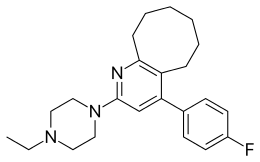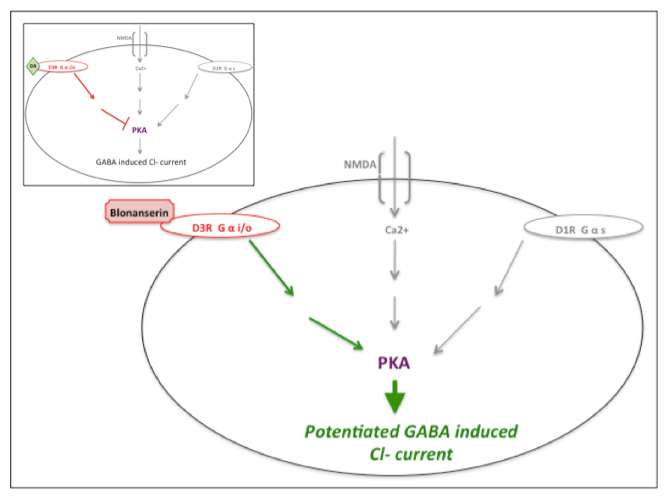Blonanserin
Blonanserin, sold under the brand name Lonasen, is a relatively new atypical antipsychotic (approved by PMDA in January 2008)[2] commercialized by Dainippon Sumitomo Pharma in Japan and Korea for the treatment of schizophrenia.[3] Relative to many other antipsychotics, blonanserin has an improved tolerability profile, lacking side effects such as extrapyramidal symptoms, excessive sedation, or hypotension.[4] As with many second-generation (atypical) antipsychotics it is significantly more efficacious in the treatment of the negative symptoms of schizophrenia compared to first-generation (typical) antipsychotics such as haloperidol.[5]
 | |
 | |
| Clinical data | |
|---|---|
| Trade names | Lonasen |
| Routes of administration | By mouth |
| ATC code |
|
| Legal status | |
| Legal status |
|
| Pharmacokinetic data | |
| Bioavailability | 55%[1] |
| Metabolism | CYP3A4[1] |
| Elimination half-life | 12 h[1] |
| Excretion | 59% (urine), 30% (faeces)[1] |
| Identifiers | |
IUPAC name
| |
| CAS Number | |
| PubChem CID | |
| ChemSpider | |
| UNII | |
| KEGG | |
| ChEMBL | |
| CompTox Dashboard (EPA) | |
| ECHA InfoCard | 100.211.656 |
| Chemical and physical data | |
| Formula | C23H30FN3 |
| Molar mass | 367.50 g/mol g·mol−1 |
| 3D model (JSmol) | |
SMILES
| |
Medical uses
Blonanserin is used to treat schizophrenia in Japan and South Korea but not in the US.[6]
Adverse effects
As with many of the atypical antipsychotics, blonanserin can elicit cardio metabolic risks. While the side effects of blonanserin – such as weight gain, cholesterol and triglyceride levels, glucose levels and other blood lipid levels – do not differ greatly from other atypical antipsychotics, the specificity of blonanserin appears to elicit milder side effects, with less weight gain in particular.[5]
Pharmacology
Pharmacodynamics
Blonanserin acts as a mixed 5-HT2A (Ki = 0.812 nM) and D2 receptor (Ki = 0.142 nM) antagonist and also exerts some blockade of α1-adrenergic receptors (Ki = 26.7 nM).[7][8] Blonanserin also shows significant affinity for the D3 receptor (Ki = 0.494 nM).[9] It lacks significant affinity for numerous other sites including the 5-HT1A, 5-HT3, D1, α2-adrenergic, β-adrenergic, H1, and mACh receptors and the monoamine transporters,[8] though it does possess low affinity for the sigma receptor (IC50 = 286 nM).[8]
Blonanserin has a relatively high affinity towards the 5-HT6 receptor perhaps underpinning its recently unveiled efficacy in treating the cognitive symptoms of schizophrenia.[7][10] The efficacy of blonanserin can in part be attributed to its chemical structure, which is unique from those of other atypical antipsychotics.[11] Specifically, the addition of hydroxyl groups to blonanserin's unique eight membered ring results in the (R) stereoisomer of the compound demonstrating increased affinity for the indicated targets.[12]
| Receptor | Ki [nM] (Blonanserin)* [7] | Ki [nM] (N-deethylblonanserin)* [3] |
|---|---|---|
| D1 | 1070 | 1020 |
| D2 | 0.142 | 1.38 |
| D3 | 0.494 | 0.23 |
| D4 | 150 | - |
| D5 | 2600 | - |
| 5-HT1A | 804 | - |
| 5-HT2A | 0.812 | 1.28 |
| 5-HT2C | 26.4 | 4.50 |
| 5-HT6 | 11.7 | 5.03 |
| 5-HT7 | 183 | - |
| α1 | 26.7 (Rat brain) | 206 (Rat receptor) |
| α2 | 530 (Rat cloned) | - |
| M1 | 100 | - |
| H1 | 765 | - |
* Towards human receptors unless otherwise specified.
Action at the Dopamine-D3 receptor
Blonanserin has antagonistic action at dopamine-D3 receptors that potentiates phosphorylation levels of Protein kinase A (PKA) and counteracts decreased activity at the dopamine-D1 and/or NMDA receptors, thus potentiating GABA induced Cl- currents.[9][13] Olanzapine does not appear to affect PKA activity.[9][14] Many antipsychotics, such as haloperidol, chlorpromazine, risperidone and olanzapine primarily antagonize serotonin 5-HT2A and dopamine-D2 receptors and lack known action at dopamine-D2/3 receptors.[9][11]
 |
| Blonanserin action at dopamine-D3 receptor. Cartoon of blonanserin's antagonistic impact at the dopamine-D3 receptor, reversing inhibition of PKA activity (also regulated by dopamine-D1 and NMDA activity) thus potentiating GABA induced Cl- current. Inset illustrates uninterrupted dopamine (DA) activity at the dopamine-D3 receptor. Inspired by Hida et al. (2014) and Yokota et al. (2002).[9][13] |
Pharmacokinetics
Blonanserin is administered 4 mg orally 2 times a day or 8 mg once a day, for an adult male with a body mass index between 19–24 kg/m2 and a body weight equal to or greater than 50 kg.[15] The drug is absorbed by a two compartment (central and peripheral) model with first-order absorption and elimination.[16] The half-life of blonanserin is dependent on the dose. A single dose of 4 mg has a half-life of 7.7 ± 4.63 h and a single dose of 8 mg has a half-life of 11.9 ± 4.3 h.[15] The increase of half-life with dose is possibly attributed to there being more individual concentration per time points below the lower limit necessary for quantification in the lower single dose.[15]
Blonanserin is not a charged compound and exhibits very little chemical polarity. The polar surface area of Blonanserin is 19.7 Å[17] It is commonly accepted that a compound needs to have polar surface area less than 90 Å to cross the blood brain barrier so blonanserin is expected to be quite permeable as is demonstrated by a high brain/ plasma ratio of 3.88.[18]
Due to the good permeability of blonanserin, the volume of distribution in the central nervous system is greater than that in the periphery (Vd central = 9500 L, Vd periphery = 8650 L) although it is slower to absorb into the central compartment.[16]
Blonanserin does not meet the criteria in Lipinski's rule of five.[17]
Effects of food intake
Food intake slows the absorption of blonanserin and increases the bioavailability peripherally relative to centrally.[16] Single fasting doses are safe and the effects of feeding intake are possibly explained by an interaction between blonanserin and Cytochrome P450 3A4 in the gut.[15]
See also
- Dopamine Receptor D3
- Lipinski's rule of five
References
- Wen, YG; Shang, DW; Xie, HZ; Wang, XP; Ni, XJ; Zhang, M; Lu, W; Qiu, C; Liu, X; Li, FF; Li, X; Luo, FT (March 2013). "Population pharmacokinetics of blonanserin in Chinese healthy volunteers and the effect of the food intake". Human Psychopharmacology. 28 (2): 134–141. doi:10.1002/hup.2290. PMID 23417765.
- "Archived copy" (PDF). Archived from the original (PDF) on 2013-01-19. Retrieved 2013-08-16.CS1 maint: archived copy as title (link)
- Deeks, ED; Keating, GM (January 2010). "Blonanserin A Review of its Use in the Management of Schizophrenia". CNS Drugs. 24 (1): 65–84. doi:10.2165/11202620-000000000-00000. PMID 20030420.
- Heading CE (November 1998). "AD-5423 (Dainippon Pharmaceutical Co Ltd)". IDrugs : The Investigational Drugs Journal. 1 (7): 813–7. PMID 18465651.
- Kishi, T; Matsuda, Y; Nakamura, H; Iwata, N (Feb 2013). "Blonanserin for schizophrenia: Systematic review and meta-analysis of double-blind, randomized, controlled trials". Journal of Psychiatric Research. 47 (2): 149–54. doi:10.1016/j.jpsychires.2012.10.011. PMID 23131856.
- Wang, SM; Han, C; Lee, SJ; Patkar, AA; Masand, PS; Pae, CU (2013). "Asenapine, blonanserin, iloperidone, lurasidone, and sertindole: distinctive clinical characteristics of 5 novel atypical antipsychotics". Clinical Neuropharmacology. 36 (6): 223–38. doi:10.1097/wnf.0b013e3182aa38c4. PMID 24201235.
- Tenjin, T; Miyamoto, S; Ninomiya, Y; Kitajima, R; Ogino, S; Miyake, N; Yamaguchi, N (2013). "Profile of blonanserin for the treatment of schizophrenia". Neuropsychiatric Disease and Treatment. 9: 587–594. doi:10.2147/NDT.S34433. PMC 3677929. PMID 23766647.
- Oka M, Noda Y, Ochi Y, et al. (January 1993). "Pharmacological profile of AD-5423, a novel antipsychotic with both potent dopamine-D2 and serotonin-S2 antagonist properties". The Journal of Pharmacology and Experimental Therapeutics. 264 (1): 158–65. PMID 8093723.
- Hida, H; Mouri, A; Mori, K; Matsumoto, Y; Seki, T; Taniguchi, M; Yamada, K; Iwamoto, K; Ozaki, N; Nabeshima, T; Noda, Y (14 August 2014). "Blonanserin Ameliorates Phencyclidine-Induced Visual-Recognition Memory Deficits: the Complex Mechanism of Blonanserin Action Involving D3-5-HT2A and D1-NMDA Receptors in the mPFC". Neuropsychopharmacology. 40 (3): 601–13. doi:10.1038/npp.2014.207. PMC 4289947. PMID 25120077.
- Tenjin, T; Miyamoto, S; Miyake, N; Ogino, S; Kitajima, R; Ojima, K; Arai, J; Teramoto, H; Tsukahara, S; Ito, Y; Tadokoro, M; Anai, K; Funamoto, Y; Kaneda, Y; Sumiyoshi, T; Yamaguchi, N (January 2012). "Effect of blonanserin on cognitive function in antipsychotic-naïve first-episode schizophrenia". Human Psychopharmacology. 27 (1): 90–100. doi:10.1002/hup.1276. PMID 22278973.
- Suzuki, K; Hiyama, Y; Une, T; Fujiwara, I (November 2002). "Crystal structure of an antipsychotic agent, 2-(4-ethyl-1-piperazinyl)-4-(4-fluorophenyl)-5,6,7,8,9,10-hexahydrocycloocta[b]pyridine (blonanserin)". Analytical Sciences. 18 (11): 1289–90. doi:10.2116/analsci.18.1289. PMID 12458724.
- Ochi, T; Sakamoto, M; Minamida, A; Suzuki, K; Ueda, T; Une, T; Toda, H; Matsumoto, K; Terauchi, Y (15 February 2005). "Syntheses and properties of the major hydroxy metabolites in humans of blonanserin AD-5423, a novel antipsychotic agent". Bioorganic & Medicinal Chemistry Letters. 15 (4): 1055–9. doi:10.1016/j.bmcl.2004.12.028. PMID 15686911.
- Yokota, K; Tatebayashi, H; Matsuo, T; Shoge, T; Motomura, H; Matsuno, T; Fukuda, A; Tashiro, N (March 2002). "The effects of neuroleptics on the GABA-induced Cl- current in rat dorsal root ganglion neurons: differences between some neuroleptics". British Journal of Pharmacology. 135 (6): 1547–55. doi:10.1038/sj.bjp.0704608. PMC 1573270. PMID 11906969.
- Nagai, T; Noda, Y; Une, T; Furukawa, K; Furukawa, H; Kan, QM; Nabeshima, T (10 February 2003). "Effect of AD-5423 on animal models of schizophrenia: phencyclidine-induced behavioral changes in mice". NeuroReport. 14 (2): 269–72. doi:10.1097/00001756-200302100-00023. PMID 12598744.
- Chen, X; Wang, H; Jiang, J; Chen, R; Zhou, Y; Zhong, W; Liu, H; Hu, P (March 2014). "The pharmacokinetic and safety profiles of blonanserin in healthy Chinese volunteers after single fasting doses and single and multiple postprandial doses". Clinical Drug Investigation. 34 (3): 213–22. doi:10.1007/s40261-013-0167-9. PMID 24399453.
- Wen, YG; Shang, DW; Xie, HZ; Wang, XP; Ni, XJ; Zhang, M; Lu, W; Qiu, C; Liu, X; Li, FF; Li, X; Luo, FT (March 2013). "Population pharmacokinetics of blonanserin in Chinese healthy volunteers and the effect of the food intake". Human Psychopharmacology. 28 (2): 134–41. doi:10.1002/hup.2290. PMID 23417765.
- "Properties Viewer"..
- Tateno, A; Arakawa, R; Okumura, M; Fukuta, H; Honjo, K; Ishihara, K; Nakamura, H; Kumita, S; Okubo, Y (Apr 2013). "Striatal and extrastriatal dopamine D2 receptor occupancy by a novel antipsychotic, blonanserin: a PET study with [11C]raclopride and [11C]FLB 457 in schizophrenia". Journal of Clinical Psychopharmacology. 33 (2): 162–9. doi:10.1097/jcp.0b013e3182825bce. PMID 23422369.